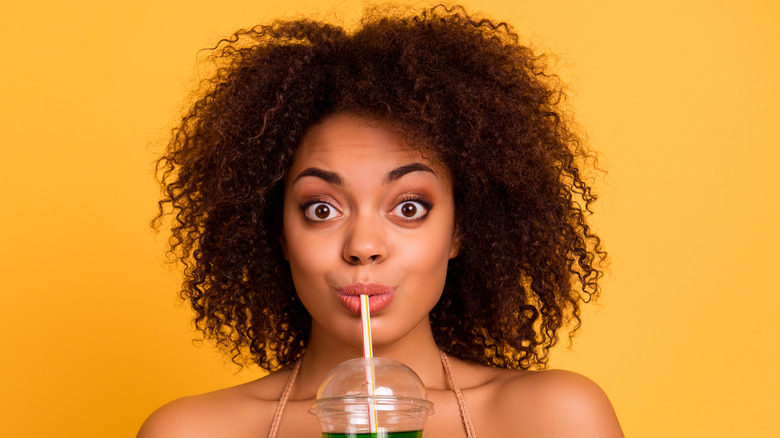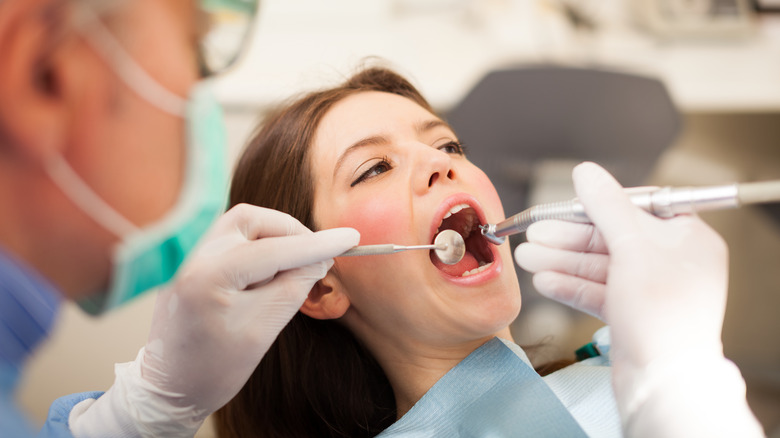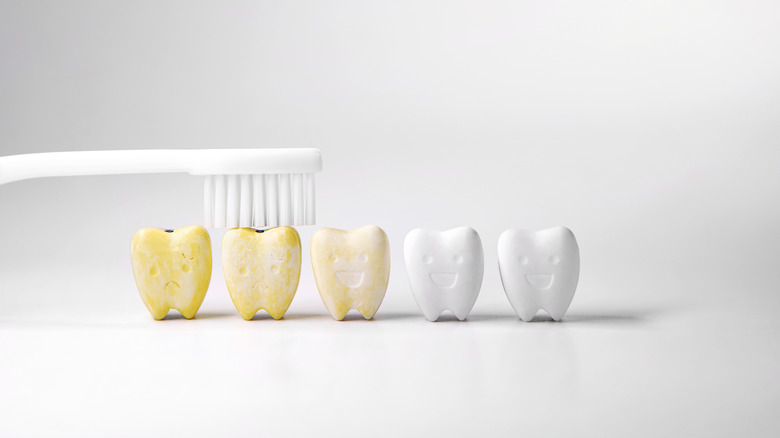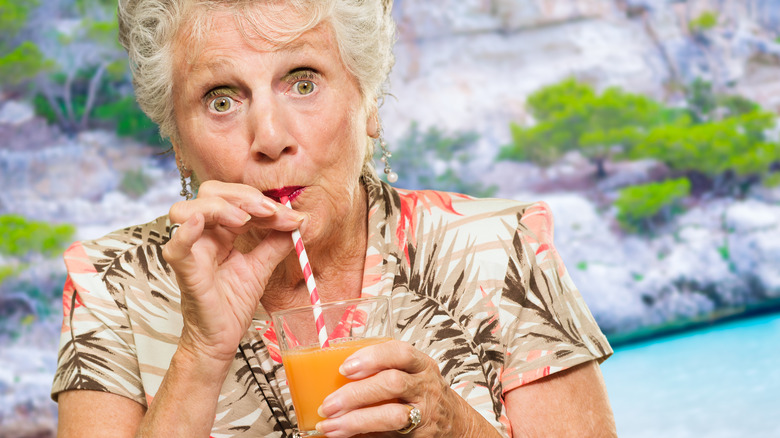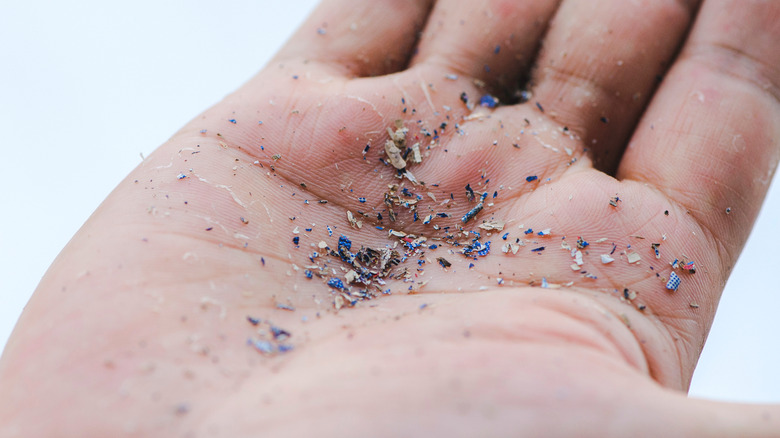Surprising Side Effects Of Drinking Through A Straw
The world produces nearly 300 million tons of plastic per year — 150 million tons of which are single-use plastics, like straws, according to the National Resources Defense Council. Over the last several years, cities and countries (and even companies, like Starbucks) around the world have begun banning single-use plastic straws and have introduced reusable or sustainable straws instead. While aesthetically pleasing silicone, sustainable bamboo, glass, and paper straws may be better environmental alternatives, you might be surprised to know that any type of straw may actually impact your health.
While utilizing straws may be convenient and in some circumstances even necessary, it is important to be aware that there are some not so desirable side effects. The downside to our trusty seemingly innocent dining accessories can range from annoying gastrointestinal discomfort to more dire chemical contamination of the human body. Let's explore just how straws can affect a persons' health.
Excess bloating
The ease in which hot and cold beverages can be consumed with the use of a straw is undeniable. When using a straw to enjoy beverages, your mouth may actually be trapping more air when compared to drinking directly from the cup (via Healthline). This air then travels throughout the digestive tract, leading to excess gas and bloating. Additionally, drinking a carbonated beverage with a straw is likely to double the amount of excess gas and bloating a person may experience. So if you'd like to pass on unnecessary flatulence or belching, skip the straw.
While straws can indeed cause excess bloating, the notion that drinking through a straw can cause people to drink more hasn't been proven (via The Washington Post). The idea behind this notion is that the ease associated with drinking from a straw causes people to consume more soda or alcohol in a shorter period of time, thus leading to a fast sugar high or a prematurely tipsy evening. While an interesting hypothesis, there are currently no studies to confirm that drinking through a straw affects the concentration of alcohol or affects the rate of intoxication.
Drinking through a straw won't really prevent you from getting cavities
If you regularly use straws to consume your sugary or caffeinated beverages, you may not even have to say anything to the dentist during your next appointment — the effects of your habit will be apparent. Drinking soda and other high-sugar beverages through a straw sends a concentrated stream of sugar towards the back of the mouth, explained The Washington Post. This concentrated stream can lead to more enamel loss, tooth decay, and ultimately more cavities.
If, however, the straw is placed behind the teeth with the stream of beverage aimed towards the throat, not the front or back teeth, there is a reduced likelihood of developing dental complications. To further protect your teeth, periodontist David Genet told Bustle that you should "swish your mouth with water, brush your teeth, or in a pinch, chew a piece of sugarless gum."
Tooth discoloration
Another potential dental complication of straw use is stained teeth. Dr. Timothy Chase, a cosmetic dentist in New York, told Bustle, "The usage of straws doesn't keep staining liquids from touching your teeth."
Beverages such as coffee, red wine, and dark teas are considered "staining" liquids. While straw use may potentially decrease teeth staining by streamlining the flow of beverages to the back of the mouth, you're likely to still experience staining on your back teeth, according to North River Dental. What you do after drinking is important. Drinking water or rinsing the mouth with water, as well as brushing your teeth are effective habits for preventing tooth stains.
While some may think only beverages can stain the teeth, it is important to understand that tooth discoloration can actually be a results of more than just drinks (via Cleveland Clinic). Certain diseases and medications can also cause tooth discoloration so using straws alone may not always mitigate the staining of the front teeth.
Drinking from a straw can lead to more wrinkles
Perhaps one of the most striking physical side effects of drinking through a straw is the development of what's called "smoker's lips." This refers to the longitudinal deep wrinkles that occur over time around the mouth and lips. Since you're pursing your lips in the same manner whether you're smoking a cigarette or drinking from a straw, those lines could in essence be renamed as "straw drinker's lips." However, using a straw occasionally should not cause wrinkles, according to dermatologist Dr. Heather Woolery-Llyod.
Dr. Woolery-Llyod told HuffPost that it is actually the frequency in which a straw is used that leads to the development of those infamous fine lines. Repetitive movements and expressions are more likely to cause wrinkles, thus avoiding frequent use of straws and cutting out bad habits such as smoking can reduce a person's risk of developing unwanted wrinkles.
Ingestion of microplastics
A 2022 study published in Environmental International from the Netherlands is the first of its kind, identifying the presence of microplastics within the body. While there is no concrete definition of microplastics, scientists typically use the term when referring to tiny plastic particles that are formed from the breakdown of commercial plastics (via National Geographic). Microplastics can enter the body as a result of using plastic water bottles, toothpaste packaged in plastic tubes, tattoo ink residues, and, of course, straws.
While it's important to note that there are alternative versions of single-use plastic straws like paper, silicone, and even glass, many people are using straws to drink out of single-use plastic containers or lined beverage containers. Plastic may be entering the body not only through the straw, but also the straw may be acting as a bridge between plastic containers and the mouth.
While there are environmental and health downsides to straw use, there are some instances in which they may be beneficial or even essential to some. This is true in people with certain disabilities who rely on the use and availability of straws for adequate and appropriate hydration and nutrition (via NPR).

